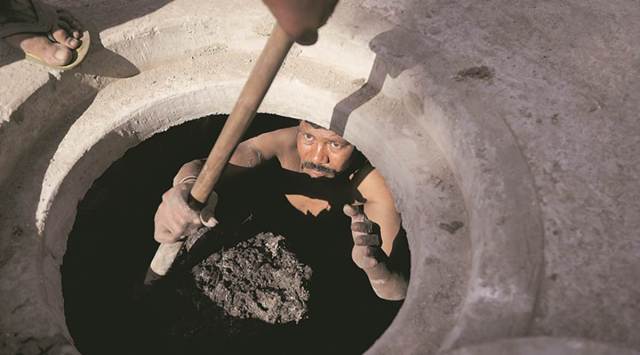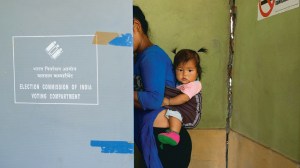- India
- International
Failing the sanitation worker again
New bill on rehabilitating manual scavengers fails to learn from failures of past Acts, focusses only on safety gears, ignores rights.
 The 74th Amendment Act and consequent codification of municipal governance is another landmark in sanitation policy in India. (Representational)
The 74th Amendment Act and consequent codification of municipal governance is another landmark in sanitation policy in India. (Representational)Written by Pragya Akhilesh
The Prohibition of Employment as Manual Scavengers and their Rehabilitation (Amendment) Bill, 2020, has been a “hidden” Bill. The non-availability of a holistic draft for any form of public consultation through the Social Justice and Empowerment Ministry’s National Action Plan is against established procedures. The Bill based on this Action Plan emphasises on the eradication of manual scavenging in India through complete mechanisation of sewer cleaning. This not only includes stricter measures for the protection of manual scavengers in terms of provision of safety gears but also stricter enforcement of compensation regulations in cases of sewer deaths. But isn’t this something we have seen before?
In 1955, the Protection of Civil Rights Act talked about the eradication of scavenging or sweeping – a profession organised based on untouchability. In 1956, the Kaka Kalelkar Commission underlined the need for mechanisation for the cleaning of latrines seven years after the Barve Commission had emphasised on the need to improve the lives of manual scavengers in India. Subsequently, both the Malkani Committee (1957) and Pandya Committee (1968) regulated the service conditions of the manual scavengers in India. Around 1980, the Centrally Sponsored Scheme of Low-Cost Sanitation for Liberation of Scavengers (ILCS) sought the conversion of dry latrines into pit latrines through an integrated low-cost sanitation scheme. 1989 was a landmark year in some ways: that year the Sub-Committee of the Taskforce constituted by the Planning Commission estimated that there were 72,050 million dry latrines in the country, the Scheduled Castes and Scheduled Tribes (Prevention of Atrocities) Act was enacted and the National Scheduled Castes and Scheduled Tribes Finance and Development Corporation (NSCSTFDC), now known as NSKFDC, for provision of financial help to the sanitation workers, was set up.
The 74th Amendment Act and consequent codification of municipal governance is another landmark in sanitation policy in India. The Employment of Manual Scavengers and Construction of Dry Latrines (Prohibition) Act, 1993 did talk of making the employment of scavengers or the construction of dry latrines an offence punishable by imprisonment or fine but it gave the state government the complete power to make schemes, rules and issue directions. The exemptions, lack of convictions for up to 20 years and the false declarations by state governments about their states being manual scavenging free failed the 1993 Act, resulting in petitions challenging its loopholes.
Constituted by the 1993 Act, the National Commission for Safai Karamcharis’s (NCSK) organisation of data has been challenged by outfits like the Safai Karmachari Andolan and Garima Abhiyan. The 2002 estimation of the Ministry of Social Justice and Empowerment of over 79 million people being engaged in this practice was also an undercount of the people engaged in this practice. The failure stemmed from the lack of an adequate definition of manual scavengers. The CAG’s report (2003) on the evaluation of the National Scheme for Liberation and Rehabilitation of Scavengers and their Dependents highlighted the failure of the 1993 Act and also shone a light on the failed investments in this regard. There has been no accountability on the disparity between estimates and actual expenditures on schemes like the Self Employment Scheme for Rehabilitation of Manual Scavengers (SRMS). On grounds of violations of the fundamental rights guaranteed under Articles 14, 17, 21 and 23 of the Constitution of India, in 2003, the Safai Karmachari Andolan filed a writ petition under Article 32 that the continuation of manual scavenging and presence of dry latrines is not only illegal but also unconstitutional. This did help in the eradication of dry latrines to a large extent. But there is no comprehensive data on the rehabilitation of the people previously employed in the dry latrines.

The National Scheme of Liberation and Rehabilitation of Scavengers (NSLRS, 1992) and SRMS, 2001 lay emphasis on skill development procedures. They talk of providing jobs but there is no provision of hand holding people who are targeted for such rehabilitation. Meenakshi, the daughter of a manual scavenger in Farukh Nagar, Uttar Pradesh says, “in the past five years, I have been to numerous skill training programmes sponsored by both the government and the NGOs. They teach us Tally and Java. I don’t follow that at all.”
There is a need for integration between various ways of rehabilitation that is not tailored towards mere numbers. The focus on availing loans through different schemes of NSKFDC, in fact, increases the vulnerability of the manual scavengers. Therefore, the rehabilitation schemes totally fail in restoring the lives of workers. Even, compensation varies after the death of a sewer worker without any concrete explanation of the estimation of the provided compensation. There is no provision of legal consultation, pension provisions or insurance cover in these schemes making the restoration and rehabilitation procedure more fractured than ever even after the Prohibition of Employment as Manual Scavengers Act, 2013 that focused more on rehabilitation than the previous Acts.
It is a sad commentary on the working conditions of these workers and their healthcare that they do not even reach the age of retirement. The important thing is these Acts and schemes should also focus on all other categorisation of sanitation workers like the faecal sludge handlers, sewage treatment plant sanitation workers, toilet sanitation workers (community, public, school, domestic household further classified into dry/wet handling), public transportation site sanitation Workers (railway, roads), sewer and drain sanitation workers, septic tank workers, waste recovery workers (household-community-landfill further classified into resource recovery sanitation workers), operational sanitation workers, sanitation-waste intersection workers. The mere inclusion of sanitation employees working on the railway platforms in the definition of manual scavengers is not enough. Shouldn’t regulations also cover workers who, in some cases, manually scavenge biomedical and hazardous waste?
The “contractual employment system” that perpetuates unregulated contractual hiring fails the existing Acts because unless there is a clear cut reassessment of this system, the number of cases of sewer deaths will keep increasing. This is why there is a sharp increase in sewer deaths as contractors force sanitation workers to enter septic tanks for manual cleaning. Three to four people die at the same time because they are pressured to enter the tank even after assessment of the risk involved in the process. Mohan from Ghitorni, Delhi, who nearly escaped death two years ago, says, “ I have seen both my friends Deepak and Balwinder die in front of my own eyes. We told the contractors that the fire from the matchstick is not sustaining in the sewer but he ignored us. My friends were asphyxiated. They were not manual scavengers, they just needed some money that day, to eat.” The lack of licensing, accountability and enforcement of the punishment of the third parties make the movements to eradicate manual scavenging in India weak. Unless we revisit this system, no Act or Scheme will help in the absolute eradication of manual scavenging in India.
Moreover, the sanitation policies emphasise only on sanitation infrastructure which is in direct conflict with the rights of the workers employed in these infrastructures. The lack of mechanisms of maintenance and proper water supply within the Toilets force the sanitation workers to “manually scavenge” human excrements and throw piles of it on nearby dumping grounds. Sullu, a Safai Karmachari from Begusarai, Bihar laments: “We get harassed by the police regularly for illegal dumping. I do not understand how I am liable for illegal dumping when there are no proper designated dumping points. If there is excrement that I have to clean from the toilets now how am I not a manual scavenger?”
Ashok Taank, head of a sanitation worker’s union in Delhi says, “there are so many sewer deaths because there is no categorisation of the sanitation workers, no emphasis on the rights, fair wage structures, policies, entitlements, restoration and rehabilitation measures. This is even the case for permanently employed sanitation workers then how will we protect our manual scavengers who are mostly seasonally employed and are daily wagers.” The absolute disregard of the recommendations of the sanitation worker’s pressure groups, unions, self-help groups, civil society organisations, academicians, policy experts and the lack of enforcement of the existing laws on the ground make makes the implementation of The Prohibition of Employment as Manual Scavengers and their Rehabilitation (Amendment) 2020, Act a non-possibility. These acts are bound to fail unless they address these issues and devise concrete enforcement programs. This is probably the reason why this “Bill is in hiding”.
(The writer is the National Convener of Rehabilitation Research Initiative India, Senior Researcher on minority communities rights with Dalit Adivasi Shakti Adhikar Manch (DASAM)
EXPRESS OPINION
More Explained
Apr 20: Latest News
- 01
- 02
- 03
- 04
- 05









































